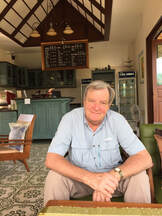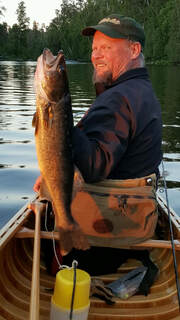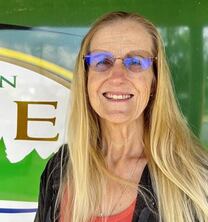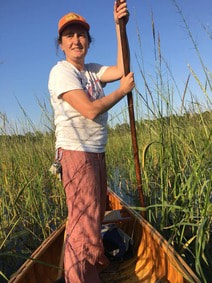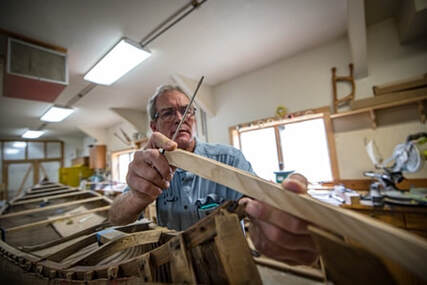Our Board of Directors
The Wisconsin Canoe Heritage Museum, Inc is a 501c3 non-profit registered in the state of Wisconsin. We have a membership that elects a governing Board of Directors, who in turn contract an Executive Director to manage the affairs of WCHM. Membership is open to all, and we welcome your participation at all levels. Our current board includes: President Dan Miller; Vice President Lynn Herman; Treasurer Deane Wilkinson; Secretary Anna Demers; and At Large Directors Benson Gray, Ron Carlson, Mike Knuth, Ed Peters, Dan Dietz, Sue Sandberg, and Jamie Dunn.
Benson GrayI grew up in Old Town, Maine and have always loved canoes so it was very exciting to learn that many other people feel the same way about these wonderful boats. My work with computers along with my interest in the history of canoes had led to some interesting collaborations. I started a project to scan the Old Town Canoe Company catalogs in the 1990s. This later developed into a much bigger effort covering a variety of canoe manufacturers with a lot of help from Dan Miller and others. My largest wooden canoe history project was to get most of the Old Town, Carleton, and Kennebec build records scanned. Projects like these have made the history of canoes more available to everyone but the real essence of an organization like the Wisconsin Canoe Heritage Museum involves connecting the people who share an interest in wooden canoes.
|
Lynn HermanI am retired from the Delaware DNR and currently my wife and I reside in Spooner. We reside at our cabin on Bass Lake off of Dock Lake Road. I have been active in the outdoors throughout my life. I am an Eagle Scout and have built two basic canoes some years ago. I have canoed a lot, especially in Maine during my undergraduate studies at the University of Maine in Wildlife Management. I have a Masters Degree from the University of Montana and spent a great deal of time outdoors there as well. I have lived in the Upper Peninsula of Michigan where I worked on a Pine Marten research project. I have sailed on Lake Superior as well, and currently own a sailboat we keep in Florida where we spend the winter.
|
Ed PetersMy interest in canoes and wooden boats comes from many influences. I grew up paddling the family’s wood and canvas canoe and rowing the “Rhinelander”. Summers during high school were spent at a canoe tripping camp, getting an appreciation for wilderness canoeing and of aluminum canoes. Since 1992, I have helped organize and lead annual trips to the Boundary Waters, Ontario, and northern Wisconsin, getting to know the various designs of fiberglass, wood, Kevlar, and Royalex canoes. In recent years, I have been restoring a canoe and boat from the Rhinelander Boat Company, as well as gathering information about the history of the factory. I enjoy the art of paddling and spending time outdoors with my wife, Mary, our three daughters, and four grandchildren. As a Wisconsin Canoe Heritage Museum board member, I have the opportunity to share my interest in the preservation of the craft and help to pass along the traditions and history of the canoe.
|
Dan MillerAt present I make my living with the Wooden Canoe Heritage Association, as editor of Wooden Canoe magazine and web master of the WCHA web site. I also manage to squeeze in a little canoe building and restoration, and am demonstrating canoe building a few days a week at the Antique Boat Museum in Clayton, New York.
|
Mike KnuthMy interest in canoes and canoe tripping spans nearly a lifetime. It all started in 1963 when my dad bought a 1930s Thompson wood canvas canoe. My brother and I used it on the local rivers of Wisconsin for many years until it was retired to the barn for about 25 years. Recognizing both the personal history and the historical value of that canoe, I did a complete restoration and I still use it to this day and often show it at local boat shows.
That led to a deeper appreciation of wooden canoes and ultimately to the WCHM. I have a fond interest in canoe tripping and over the years have made many trips in the BWCA, Quetico, and Wabakimi Provincial parks. In 1996 and 1999, I organized two trips that retraced most of Sigurd Olson’s 1955 trip down the Churchill River in Saskatchewan described in his book the “The Lonely Land”. Recently, I have taken much interest in the WCHM. I have restored a canoe, built a skin on frame Greenland Kayak, and am currently building a replica of an 1881 J.H. Rushton Rob Roy design which he called the American Traveling Canoe. This project is my foray into lofting and lapstrake construction. I have taken a great interest in the works of Rushton and have studied the company history. Many of these projects were in part inspired and spurred on by my connection to the WCHM. |
Sue SandbergI grew up near canoe country and learned a lot about canoeing with the Boy Scouts. My brothers and I harvested wild rice and tripped the wilderness in our youth and continue to this day. Now I have found a passion for wood and canvas canoes and am happy to work with WCHM.
My interest in canoes began in Girl Scouts where we flipped and learned to right canoes in deep water. College and working years involved trips to the Boundary Waters. My husband Bill and I built a cedarstrip canoe under the guidance of work friends, with one providing the strongback and molds. We built a “Chestnut Prospector” from the Canoecraft book by Moores and Mohr using the West System. It had a successful maiden voyage to the boundary waters. Now, hanging on our log rafters in our Webb Lake cabin is this cedarstrip canoe, as well as a birchbark canoe made by Hafeman Boatworks of Bigfork, Minnesota. Two vintage canvas canoes also grace our cabin walls. I am recently retired from the University of Minnesota research labs of the medical school and will complete a masters’ degree in the biological sciences (MBS) in December 2022. I love all things ‘biology’, from field biology to laboratory medicine. Especially, I enjoy living in the Northwoods on a lake surrounded by native plants and animals and being close to the Brule and Namekagon rivers. |
Dan DietzI was raised paddling and rowing around a small lake outside Danbury Wisconsin where our families’ summer cabin was located. I would only stop fishing when driven off the lake by the swarms of mosquitos and darkness. We have had our own cabin on Webb Lake for over twenty years now where I have three canoes on a self-built rack. One hand me down canoe, one salvaged, and one purchased. I have not missed my annual canoe trip down the Namekagon for over 40 years. We also enjoy canoeing other rivers including the Brule River (flowing north into Lake Superior) which is our favorite waterway. I have been collecting paddles for many, many moons by means of salvaging, bartering, and buying. The old paddles are getting harder and harder to come by. I have worked for Graco Inc. (a Minneapolis based manufacturing company) for 25 years after graduating from the University of Minnesota with a Manufacturing Management degree. Our favorite canoes at the Spooner Museum are the guide models with the comfortable seat for the client. I truly love the water, and I am fascinated by all boats.
|
Deane WilkinsonAfter being introduced to kayaking and canoeing in CA by my husband, my real interest in canoeing began in 2006 after moving to Spooner WI. We began canoeing local rivers immediately. Eventually we learned about the boundary waters and coordinated a family trip and the passion of canoeing grew from there. We watched the feed store building as it was transformed into the museum and we have been involved as Key Masters since day one. My interest in becoming a board member is to further my knowledge about canoes in our history to not only enrich my life, but the lives of the visitors we meet at the museum. It is my hope to bring ideas to help raise interest in the community and with our youth. We have learned a great deal about the skills of canoeing and even competition opportunities. I have watched the WCHM grow year after year and I want to bring what I can to continue its growth
|
Organizational Papers
|
WCHM Articles of Incorporation
|
WCHM By-laws
|
WCHM 2017 Board Manual
| ||||||||||||||||||


